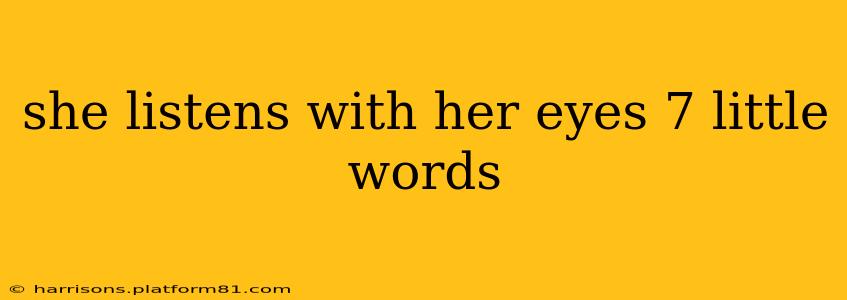She Listens With Her Eyes: Unpacking the Meaning of This Phrase
The phrase "she listens with her eyes" evokes a powerful image, suggesting a depth of empathy and understanding that goes beyond simply hearing words. It implies a keen attentiveness to nonverbal cues, a sensitivity to unspoken emotions, and a capacity for profound connection. This evocative phrase, often used in literature and everyday conversation, hints at a level of communication that transcends the spoken word. Let's delve deeper into what it means.
What does "she listens with her eyes" actually mean?
This phrase describes someone who is a highly perceptive and empathetic listener. It means she's not just passively hearing the words being spoken, but actively observing the speaker's body language, facial expressions, and overall demeanor to gain a complete understanding of their message. This includes paying attention to subtle cues that might reveal hidden emotions or unspoken anxieties. It suggests a level of intuitive understanding and a willingness to connect on a deeper, more emotional level.
Is "she listens with her eyes" a metaphor?
Yes, absolutely. It's a powerful metaphor that uses the imagery of sight to represent the act of deeply attentive listening. It highlights the importance of nonverbal communication and emphasizes the role of observation in truly understanding another person. The eyes, often described as the windows to the soul, become the gateway to understanding someone's true feelings and intentions.
Why is it important to listen with your eyes?
Listening with your eyes enhances communication significantly. By incorporating nonverbal cues into your comprehension, you gain a far richer understanding of what the speaker is communicating. This approach fosters stronger relationships, increases empathy, and improves the overall effectiveness of communication. Misunderstandings can be minimized because you're picking up on the subtle nuances that spoken words might miss.
What are some examples of listening with your eyes?
Consider these scenarios:
- A friend is telling you about a difficult day at work. Listening with your eyes means noticing their slumped posture, downcast gaze, and subtle sighs – all indicators of stress and frustration. Your understanding of their experience goes beyond simply hearing the words they speak.
- A child is trying to communicate a need. A child might not be able to articulate their feelings perfectly, but their body language – clinging, fidgeting, or tearful eyes – might be telling you everything you need to know. Listening with your eyes allows you to respond appropriately to their unspoken distress.
- A loved one is sharing a difficult memory. Their facial expressions, pauses, and changes in tone can provide crucial context that deepens your understanding and compassion.
By paying attention to these nonverbal cues, you demonstrate that you are truly present and engaged in the conversation, strengthening the connection with the speaker.
How can I improve my ability to listen with my eyes?
Improving your ability to "listen with your eyes" requires conscious effort and practice. Focus on:
- Minimizing distractions: Put away your phone, make eye contact, and give the speaker your full attention.
- Observing body language: Pay close attention to posture, facial expressions, gestures, and tone of voice.
- Practicing empathy: Try to understand the speaker's perspective and feelings.
- Asking clarifying questions: Don't be afraid to ask questions to ensure you understand their message fully.
In conclusion, "she listens with her eyes" is more than just a catchy phrase; it describes a powerful skill that fosters deeper connections and more effective communication. By consciously improving our observation skills and practicing empathy, we can all learn to listen with our eyes and truly understand those around us.
